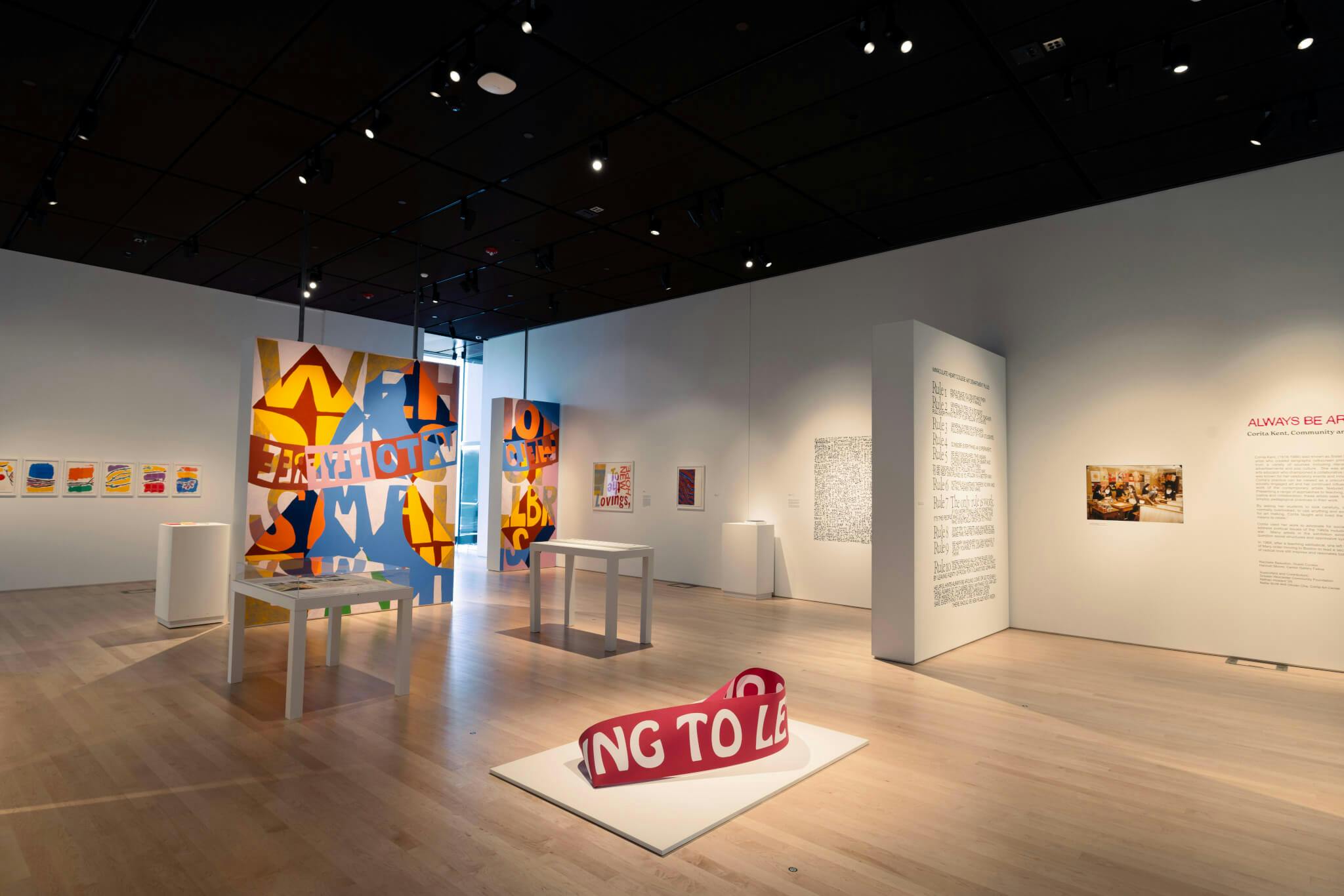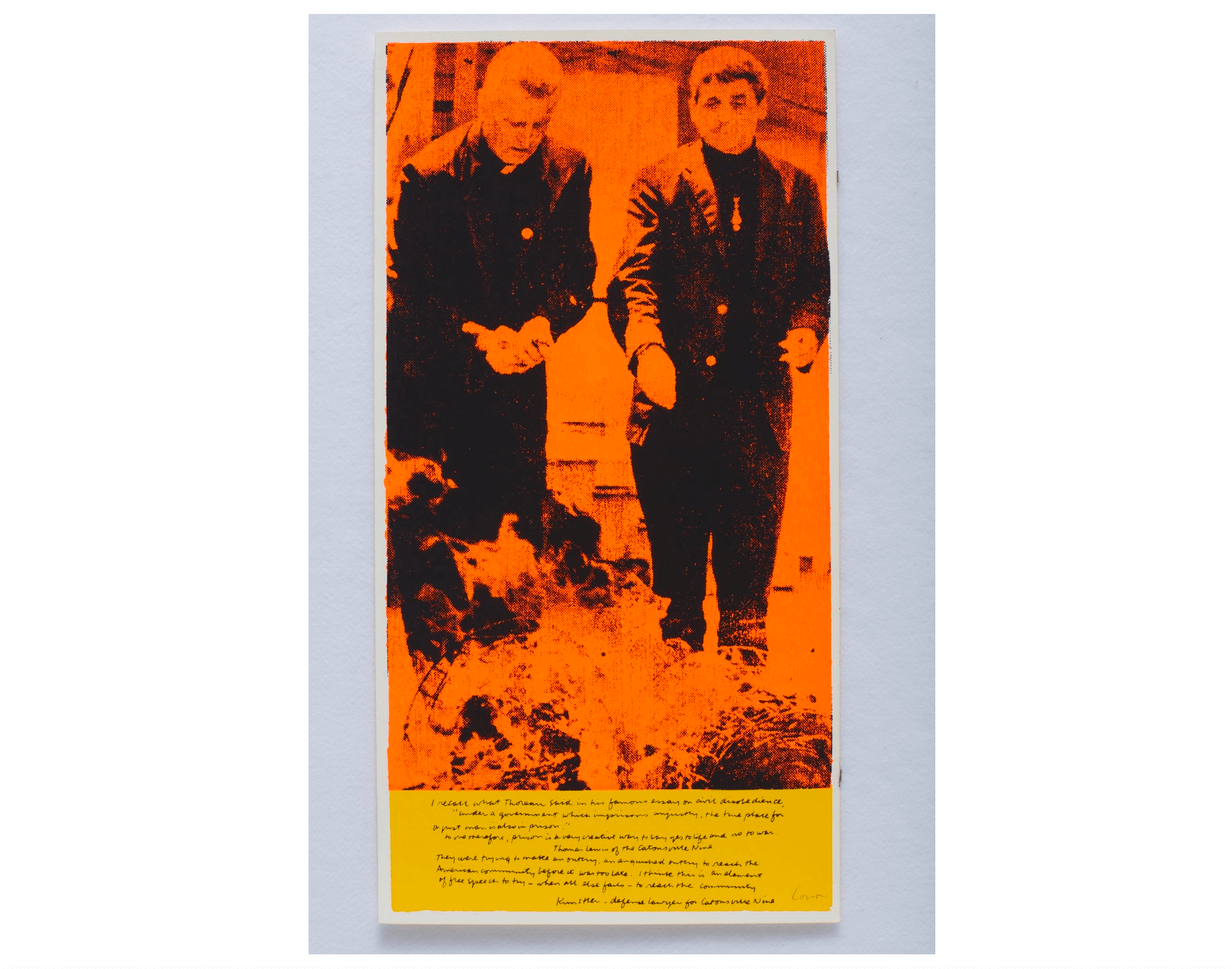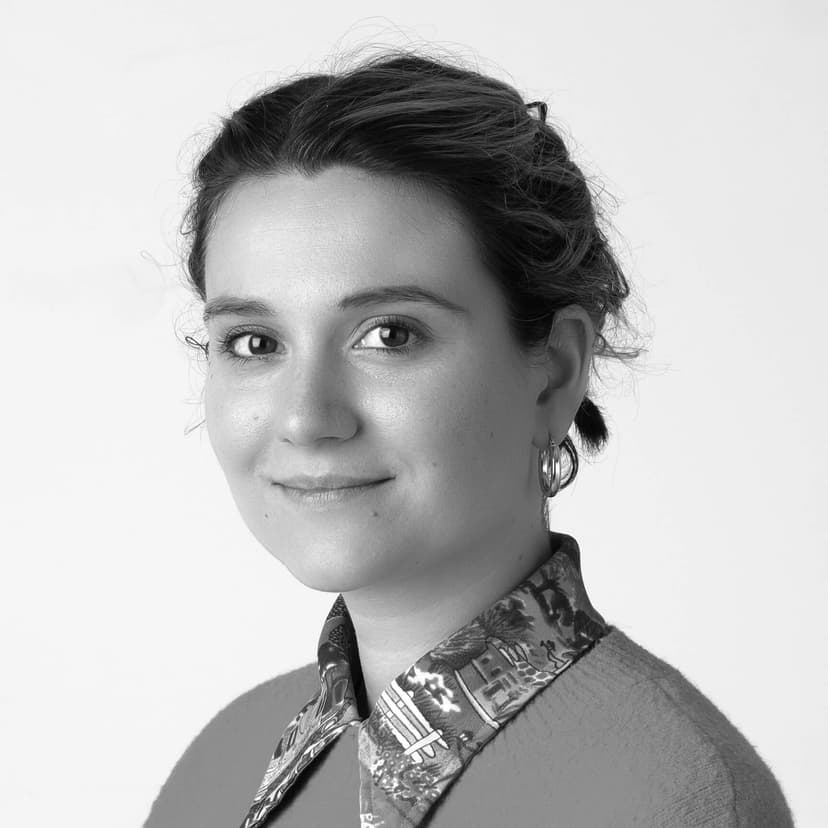The ten maxims of the Immaculate Heart College Art Department Rules welcome visitors to “Always Be Around: Corita Kent, Community and Pedagogy,” an exhibition of prints by the late Corita Kent (1918–1986) alongside works by contemporary artists at the College of the Holy Cross in Worcester, Massachusetts. Created by Kent in collaboration with her students, the rules begin “Find a place you trust and then try trusting it for a while” and conclude with a quote by John Cage: “‘We’re breaking all the rules. Even our own rules. And how do we do that? By leaving plenty of room for X quantities.’”
Situated in the campus art gallery, this syllabus-like first encounter may feel habitual to students, although the looseness of the decrees makes them far from doctrine. Kent utilized the rules to run an educational program of creativity, curiosity, and experimentation at the art department of the Immaculate Heart College (IHC) in Los Angeles in the 1950s and ’60s.
A Roman Catholic nun in the Immaculate Heart of Mary (IHM) order during these years, Kent produced silkscreened “serigraphs” on paper in her own practice and with her students, integrating the language of social justice and reform with popular advertising. Her print enriched bread (1965) depicts the stripes of primary colors and sans-serif font characteristic of the Wonder Bread brand (“helps build strong bodies 12 ways”). Within this graphic composition, Kent added a quote by Albert Camus in handwritten script:
Some will say this hope lies in a nation; others in a man. I believe rather that it is awakened, received, nourished by millions of solitary individuals whose deedsand works everyday negate frontiers and the crudest implications of history …
Nourished, here, is the thematic tie to the Wonder Bread sloganizing. Kent believed in culling content from what was ubiquitous in LA’s freeways and strip malls and elevating it with liberatory quotes or imagery. The work’s label, written by college junior Nathan Howard, shares that Kentsaw Andy Warhol’s Campbell’s Soup Cans in 1962, which inspired her Pop art alignment.
Kent’s works from the 1960s, which largely comprise what is on view, are egalitarian in format and concept. Just as she incorporated commercial references that would resonate widely, Kent chose printmaking for its accessibility. She considered it a democratic medium that made visual culture available to those who could not afford high art.
Forces of cultural life in LA at the time, Kent and the IHM sisters liberally interpreted the Vatican II Decree on the Adaptation and Renewal of Religious Life, which encouraged members of religious orders to adapt their practices to the needs of modern times. They supported Vietnam War dissenters and contributed signage for various humanitarian protests. The print phil and dan (1969) from Kent’s heroes and sheroes series reproduces a newspaper image of the Berrigan brothers, both priests, burning their draft cards (Philip Berrigan, the adjacent label notes, was a Holy Cross grad). The nuns bucked up against the conservative Cardinal McIntyre, who considered their liberal interpretation of the decree sacrilegious. This pressure from local ecclesiastic authorities led to the majority of the IHM sisters leaving the Church in 1970 and forming the Immaculate Heart Community.
Kent had already left the order at this time, moving to Boston in 1968 to lead a secular life. Her reasons for departing were as much about burnout from a crazy teaching and art production schedule as burnout from the Church’s conservatism. The exhibition displays the moments series (1977) from her post-IHM era. The eleven serigraphs feature colorfields of rainbow hues interjected with blooming branches and overlaid with handwritten adages (“flowers grow out of dark moments”). The moments are far less typographic and politically pointed than earlier pieces and mark a shift that mirror Kent’s lifestyle change from campus renegade to studio artist with an abstract bent.
The selection of works by Kent in the exhibition hit these major periods in her oeuvre. For students and East Coasters not familiar with the work, it is helpful to see this retrospective-in-miniature.
Contemporary projects are interspersed throughout, and it is hard at times to understand the logic of the hang. A blown-up page of an artist book by Mary Lum configures the lettering from the “Papers of Corita” archive at Harvard into a patchwork quilt of illegible cyphers. Inspired by Kent’s deviceful graphic design, Lum’s piece is clearly tied to her legacy. However, by using the uniform typewritten pages of the archive, Lum’s interpretation doesn’t formally recall Kent’s often askew, lopsided typography. While this is a completely understandable artistic departure, a topical connection in process or material would have better bridged the new with the old. Kent’s Rules could have been useful here, offering a structure to thematically tie Lum’s work to her vision.
Lukaza Branfman-Verissimo’s colorful wall murals provide a more legible connection to Kent, as the artist employed Kent’s finder method of focusing on one thing through a small cut-out to create letterform abstractions. Dispersed on a handful of the gallery’s moveable walls, the murals offer an exciting departure in scale from the modest prints and archival material that populate the rest of the show.
The most compelling projects are the ones that engage the immediate Holy Cross community. Jorge Lucero, an artist and professor at the University of Illinois Urbana-Champaign, invited faculty to participate in a workshop where they considered how they take permission from creative influences to continue the often thankless, arduous endeavor of teaching—a challenge Kent openly spoke about. Under a chosen premise (cooking, the 2004 Boston Red Sox roster, etcetera), each participant wrote their reflections on notebook paper. Presented in a large grid, these include “From banana bread I get permission to make rotten beautiful” and “From Nomar Garciaparra I accepted permission to ignore the haters.”
In November, artist and educator Roz Crews is organizing a “Mary’s Day” event. Inspired by the 1964 celebration-protest of the same name overseen by Kent at IHC, Crews is collaborating with the student-run Pride organization, among others from the Worcester area, to make signs focused on current social issues, particularly in the Church (the most pressing being the transphobic mandate by the Worcester diocese for students in K–12 Catholic schools to conduct themselves according to their biological sex). While there is only a short description of this future event, archival photos of students and IHC sisters in habits and flower crowns, strumming guitars, and carrying placards reading“GOD LIKES ME” or “PEACE PEACE PEACE” give a taste (albeit with a very 1960s flavor) of how Kent’s Mary’s Day will translate to a public expression of student grievances.
Visiting “Always Be Around” on a sleepy Monday during the school’s fall break meant I didn’t experience the show in its intended environment. Stationed on the second floor of the college’s new Diller Scofidio + Renfro–designed arts building, the gallery overlooks the “hive,” or the open atrium and café usually teeming withundergrads. Many of the contemporary artists on view would fall under the “social practice” umbrella of art making, where community engagement is paramount to completing a work, and for “Always Be Around” Holy Cross students provided this essential matter. While thinkers like Claire Bishop have notably critiqued these kinds of projects for being celebrated for their process rather than their aesthetics or impact, social practice seems to work at a pedagogical institution, where making involves the efforts of many and should therefore be evaluated by the means with which an artist brings an idea into the world.
What Kent understood about working at a school is that it is malleable to innovation. The strength of “Always Be Around” is that it is not in a large museum and therefore does not have to cater to the so-called general public. Unlike sanctioned efforts by museums to invite institutional critique, which often fall short of encouraging any real change, Kent’s permissive “rules” and ethos can make a very real impact on students and faculty—in developing their own critical, creative processes for dealing with the powers that be (the Church, the stresses of studying and teaching). At Holy Cross, she is a perfect fit.
“Always Be Around: Corita Kent, Community and Pedagogy” is on view at the Iris and B. Gerald Cantor Art Gallery at the College of the Holy Cross through December 15, 2023.
This piece was originally published in print in Issue 11: Emerge, our fall/winter edition of our biannual publication.



